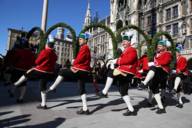
The time has finally come again in 2026! Then the Munich Schäffler will once again perform in the city's public squares. Their historic round dance follows a centuries-old choreography. The dance is only performed every seven years in accordance with an oath. After all, what still brings the public much joy today was created in the late Middle Ages for a sad reason. Read the whole story here.
In 2026, the Schäffler will once again perform in Munich's public places for several weeks. Their dance follows a music-supported sequence of different dance figures with evocative names such as “Laube (pergola)“, “Kreuz (cross)“, “Schlange (snake)“ and “Krone (crown)“. Each performance begins and ends with the so-called Bavarian “Defiliermarsch”. There is at least one “Kasperle“ (Joker) in the dancers' entourage, who suddenly jumps into the crowd and colours some of the spectators' noses black. Nobody gets too upset about this, as it is supposed to bring good luck.
In 2022, the Schäffler deviated from their seven-year rhythm for once, because, following their mission, they wanted to bring a bit of confidence back to the beleaguered urban society towards the end of the corona virus pandemic.
In the mid-14th century, Munich was repeatedly struck by plague outbreaks. Despite numerous pilgrimages to the Andechs Monastery, the plague continued to ravage the city.
In particularly severe years, it claimed the lives of up to a third of the population,with the late 15th century experiencing its most devastating effects. Finally, after the epidemic in 1517, the guild of Munich barrel makers is said to have gathered for the first time to entice the long-suffering Munich population back onto the streets with their dance performances. They wanted to celebrate life and inspire confidence for the future. A scene in the famous Munich Glockenspiel (carillon) in the tower of the Neues Rathaus (New Town Hall) on Marienplatz (main square) brings this episode from the city's history back to life every day.
According to oral tradition, the Schäffler then took a vow, though there is no evidence of this: Should the plague not occur again, they would perform their dance every seven years to commemorate the alleviation at the end of this terrible time. This tradition is still practised in Munich to this day.
The barrel makers were once as much a part of Munich as the breweries: They made the barrels in which beer was delivered to pubs and the rest of the world. Today, there is only one cooper left in the city: Wilhelm Schmid in Laim. Schmid also has to ensure that the tradition of the Schäffler dance lives on. The dance is still exclusively performed by men. Initially, only “real“ barrel makers were permitted to participate, but in recent years, dancers from other professions have been able to join in. This change is the result of the decline in traditional trades, leading to a dwindling number of barrel makers over time. In Munich, the “Fachverein der Schäffler“ has organised the dance since 1871.